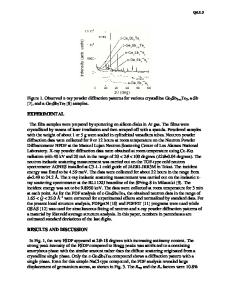Structural and Optical Properties of Amorphous Ge 2 Sb 2 Te 5
- PDF / 213,813 Bytes
- 6 Pages / 612 x 792 pts (letter) Page_size
- 37 Downloads / 348 Views
0918-H02-05
Structural and Optical Properties of Amorphous Ge2Sb2Te5 Heng Li1, T. Ju1, T. Herring1, P. C. Taylor2, D. L. Williamson2, M. J. Nelson3, and C. E. Inglefield3 1 Physics, University of Utah, Salt Lake City, UT, 84112 2 Physics, Colorado School of Mines, Golden, CO, 80401 3 Physics, Weber State University, Ogden, UT, 84408 ABSTRACT The optical and structural properties of amorphous sputtered films of Ge2Sb2Te5 depend strongly on the preparation conditions. Films grown at higher growth rates exhibit greater local strains as indicated by the slope of the optical absorption in the exponential “band-tail” region, but these films also incorporate smaller densities of oxygen impurities. At slower growth rates the band-tail slopes are sharper (smaller local strains) but there is greater oxygen incorporation. We will discuss several experiments that suggest that the local strain relief in the films grown at slower growth rates is due to a greater ability of the atoms to rearrange on the growing surface and not to increased oxygen incorporation. Small angle x-ray scattering experiments show that the films exhibit small elliptical “voids” with long axes perpendicular to the growing surface. The approximate dimensions of these voids are 3 x 20 nm. These films can be switched optically with little change in surface topography as measured by atomic force microscopy. Electron spin resonance measurements indicate that paramagnetic defects exist in some films but are either absent or below the detection limit (~ 1018 cm-3) in most films. The implications of these results for the switching mechanisms will be discussed.
INTRODUCTION Chalcogenide glasses have been studied for many years. In most of these glasses the chalcogen atom is primarily two-fold coordinated and the top of the valance band is the non-bonding, or lone pair, band localized on the chalcogen atoms. Partly as a result of the low nearest neighbor coordination number of the chalcogen atoms, a large lattice relaxation accompanies the optical or electrical electronic excitations. This strong electron-lattice interaction has dramatic consequences for both the optical and electronic properties, including the inability to dope these glasses. There are exceptions to this general behavior when the average nearest neighbor coordination number increases. Any microscopic understanding of the phase change processes requires knowledge of the structures in both the crystalline and amorphous phases as well as any lattice relaxations that occur after electronic transitions to excited states.
EXPERIMENTAL DETAILS Amorphous films of Ge2Sb2Te5 were sputtered onto quartz, aluminum foil, or glass microscope slides. Each substrate was cleaned as described in a previous publication [1] and placed directly into the sputtering chamber. A sputtering target of Ge2Sb2Te5 was made by slumping ingots in an evacuated quartz ampoule. The ingots were made by melting 99.9999 % pure elemental constituents. Thin film samples of Ge2Sb2Te5 were sputtered onto room temperature substrates usin
Data Loading...











